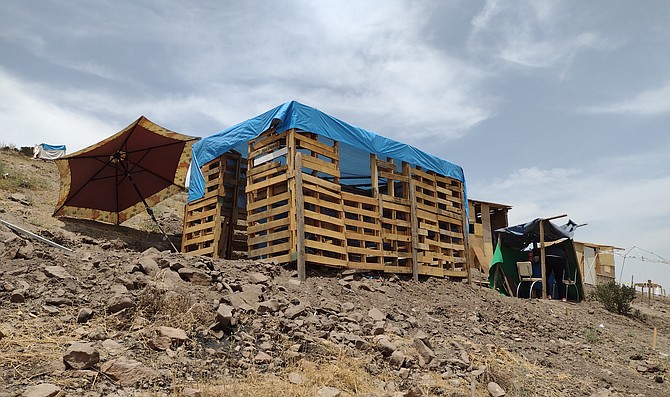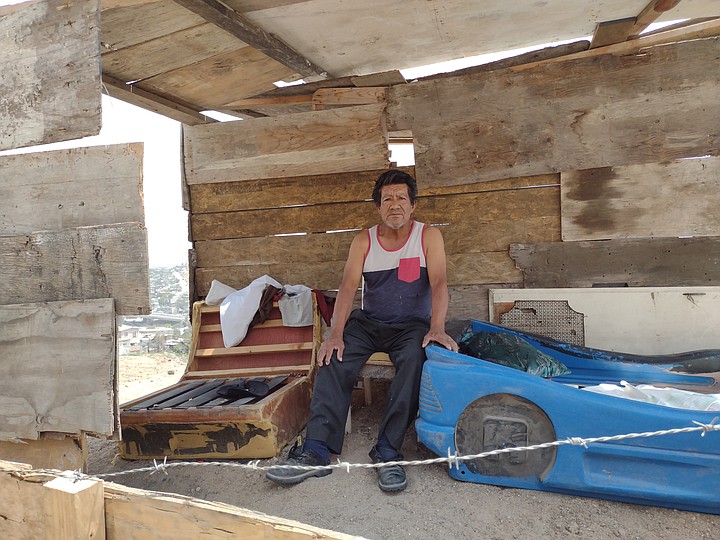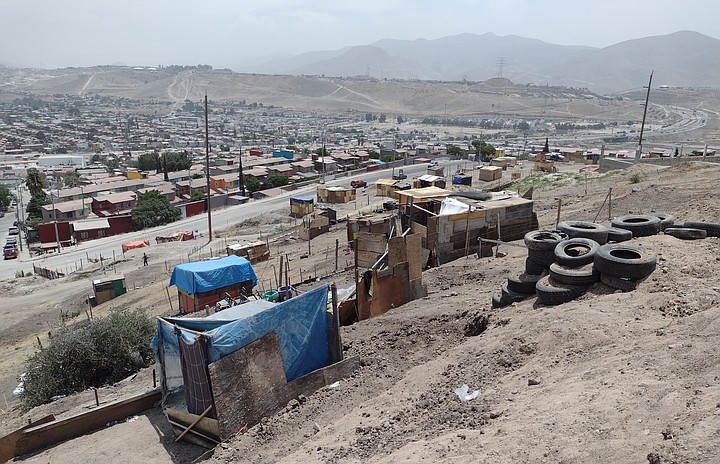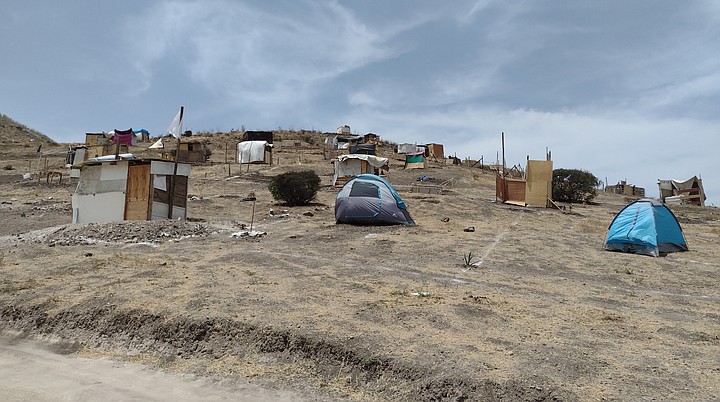 Facebook
Facebook
 X
X
 Instagram
Instagram
 TikTok
TikTok
 Youtube
Youtube

At least 277 families have settled in and started a new neighborhood near the east edge of the city. The media calls El Cerro de las Abejas, 22 miles from the border, “the poorest neighborhood in Tijuana." Despite the extreme heat during the day and cold at night, migrants like Maria, originally from Nayarit, decided to settle in this area without public services and in huts made from recycling materials.
“I was living in a shelter, but there we had to pay 500 pesos (25 U.S. dollars) per week. For me it's complicated because I have a daughter who has developed an infection and needs certain medicine. Right now the heat is a big problem for us, and we’re getting water from a tanker truck that comes just sometimes. It has been really hard.”

Jose Rulfo, an older man who spent 26 years living in the United States and now has a kidney stone problem, is unable to work. “I’m struggling with this kidney issue I have; the doctor gave me pills for it but I’m still in pretty bad condition. I have a daughter in the U.S., and she helps me sometimes, but I don’t like to be asking her so often for help. I am a really good worker, and now I can't even do that because of my kidney.”
The settlement has troubled some neighbors since the new families started coming in June. The tipping point of the invasion came June 23. Soon thereafter a group from the adjacent Las Abejas neighborhood held a protest at city hall demanding eviction of the 277 families; they were afraid that insecurity would rise in their neighborhood.

Salvador Garcia, one of the neighbors' leaders: “Near there is a soccer field that they are also invading. We have to defend that hill because it has been used by neighbors that have lived here years and years. And some are taking electricity from the public line without paying.” .
On July 16, Tijuana’s Police Department tried to enforce an order from city hall to evict the settlers, but the half dozen police patrols and a bulldozer were used just to threaten and persuade the invading families to leave voluntarily.
One of the squatters: “A lot of police came that day; they told us that we had 72 hours to leave. They gave us a paper where it says that we could earn 1 to 6 years in prison for invading. But nothing has happened. We had our things here like our stove, but because of fear that the police can take belongings, we keep them with my husband’s family”.

According to Tijuana’s police department, 70 percent of the people left after the warning, but the most vulnerable remained. Now they are waiting because of a legal loophole. On July 23, Governor Jaime Bonilla visited the Las Abejas neighborhood and promised the settlers public property lots no more than 20 minutes away for 100 pesos (5 dollars).
Ali Ozuna, a neighbor who had protested the settlers: “We all are struggling, they want things the easy way. Why doesn’t the governor help families who have debts to pay on their houses. It’s just unfair.”
Settlers are convinced the promise is a smokescreen, because Jaime Bonilla leaves the government in three months. “We just want proper housing for our families because rents are just impossible to pay,” Maria said. And now with just about 30 percent of the people remaining, Maria feels more insecure because according to her, they were all taking care of each other, but now in their legal and social loophole, Maria and her neighbors are more vulnerable.


At least 277 families have settled in and started a new neighborhood near the east edge of the city. The media calls El Cerro de las Abejas, 22 miles from the border, “the poorest neighborhood in Tijuana." Despite the extreme heat during the day and cold at night, migrants like Maria, originally from Nayarit, decided to settle in this area without public services and in huts made from recycling materials.
“I was living in a shelter, but there we had to pay 500 pesos (25 U.S. dollars) per week. For me it's complicated because I have a daughter who has developed an infection and needs certain medicine. Right now the heat is a big problem for us, and we’re getting water from a tanker truck that comes just sometimes. It has been really hard.”

Jose Rulfo, an older man who spent 26 years living in the United States and now has a kidney stone problem, is unable to work. “I’m struggling with this kidney issue I have; the doctor gave me pills for it but I’m still in pretty bad condition. I have a daughter in the U.S., and she helps me sometimes, but I don’t like to be asking her so often for help. I am a really good worker, and now I can't even do that because of my kidney.”
The settlement has troubled some neighbors since the new families started coming in June. The tipping point of the invasion came June 23. Soon thereafter a group from the adjacent Las Abejas neighborhood held a protest at city hall demanding eviction of the 277 families; they were afraid that insecurity would rise in their neighborhood.

Salvador Garcia, one of the neighbors' leaders: “Near there is a soccer field that they are also invading. We have to defend that hill because it has been used by neighbors that have lived here years and years. And some are taking electricity from the public line without paying.” .
On July 16, Tijuana’s Police Department tried to enforce an order from city hall to evict the settlers, but the half dozen police patrols and a bulldozer were used just to threaten and persuade the invading families to leave voluntarily.
One of the squatters: “A lot of police came that day; they told us that we had 72 hours to leave. They gave us a paper where it says that we could earn 1 to 6 years in prison for invading. But nothing has happened. We had our things here like our stove, but because of fear that the police can take belongings, we keep them with my husband’s family”.

According to Tijuana’s police department, 70 percent of the people left after the warning, but the most vulnerable remained. Now they are waiting because of a legal loophole. On July 23, Governor Jaime Bonilla visited the Las Abejas neighborhood and promised the settlers public property lots no more than 20 minutes away for 100 pesos (5 dollars).
Ali Ozuna, a neighbor who had protested the settlers: “We all are struggling, they want things the easy way. Why doesn’t the governor help families who have debts to pay on their houses. It’s just unfair.”
Settlers are convinced the promise is a smokescreen, because Jaime Bonilla leaves the government in three months. “We just want proper housing for our families because rents are just impossible to pay,” Maria said. And now with just about 30 percent of the people remaining, Maria feels more insecure because according to her, they were all taking care of each other, but now in their legal and social loophole, Maria and her neighbors are more vulnerable.
Comments